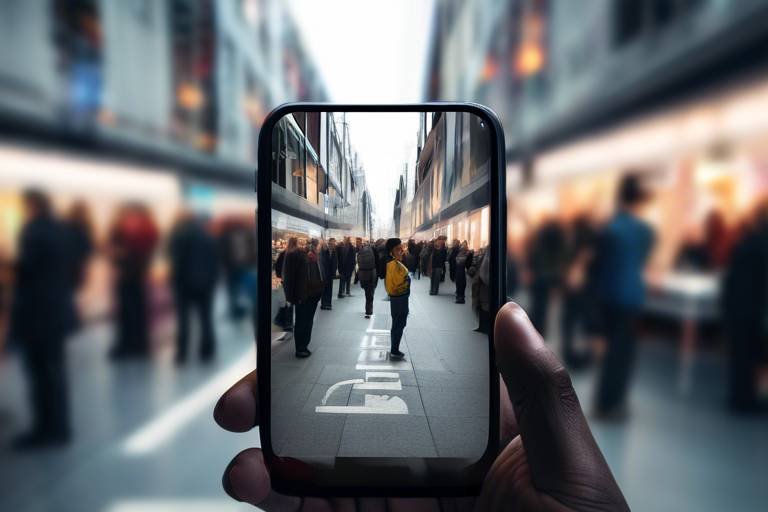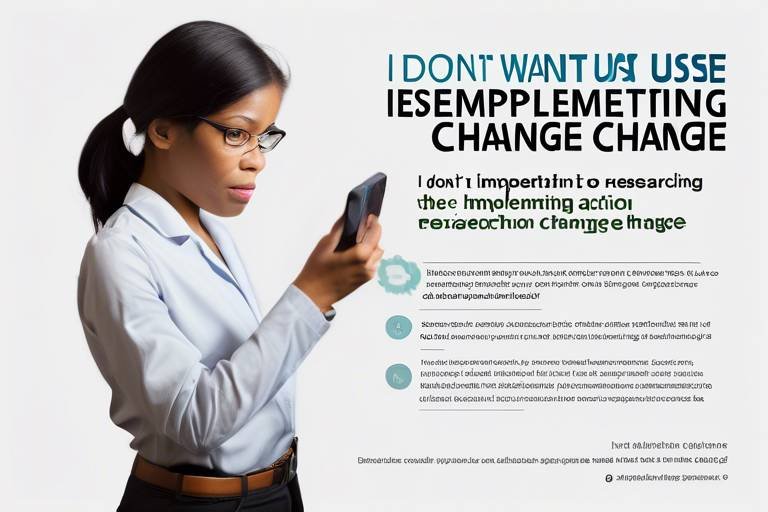How to Conduct Research Using Mobile Ethnography
In today's fast-paced world, understanding human behavior has become more crucial than ever, especially in fields like marketing, social sciences, and user experience design. Mobile ethnography is a groundbreaking qualitative research method that leverages the power of mobile technology to gather insights directly from individuals in their natural environments. Imagine being able to step into someone's shoes, observing their day-to-day activities, and capturing their genuine reactions—all in real-time. This approach not only enriches the data collected but also provides a deeper understanding of the complex factors influencing people's behaviors and experiences.
At its core, mobile ethnography is about harnessing mobile devices to gather qualitative data. Unlike traditional ethnography, which often requires researchers to immerse themselves in a specific environment for extended periods, mobile ethnography allows for a more flexible and immediate approach. Participants can share their experiences through their smartphones or tablets, providing researchers with a wealth of information that reflects their real-life contexts. This method is particularly effective because it captures spontaneous behaviors and thoughts that might otherwise go unnoticed. Think of it as having a window into the everyday lives of individuals, where every moment can reveal valuable insights.
Why should researchers consider mobile ethnography? The benefits are numerous and compelling. First and foremost, it increases accessibility. Participants can engage with the research process from anywhere, breaking down geographical barriers and allowing for a more diverse sample. Additionally, the real-time data collection aspect means that researchers can gather insights as events unfold, providing a dynamic view of participants' experiences. This immediacy is crucial for capturing authentic user experiences, as it allows individuals to share their thoughts and feelings in the moment.
One of the standout features of mobile ethnography is its ability to foster deeper participant engagement. By utilizing multimedia tools, participants can share their experiences in a more interactive and personal way. For example, instead of simply answering survey questions, they can record videos, take photos, or even provide audio notes about their experiences. This not only makes the research process more enjoyable for participants but also enriches the data collected. The result is a more nuanced understanding of their perspectives and experiences.
Incorporating various forms of media into the research process can significantly enhance the richness of the data. For instance, a participant might take a photo of a product they use daily and describe their feelings about it in an audio recording. This combination of visual and auditory data creates a more comprehensive picture of the participant's experience. Researchers can analyze these materials to identify patterns and themes that might not emerge from traditional text-based data alone.
Another advantage of mobile ethnography is the ability to obtain real-time feedback. Participants can provide immediate insights during their daily activities, capturing spontaneous thoughts and reactions that might be missed in more structured research settings. For example, if a participant is using a new app, they can quickly share their thoughts about its usability right after their experience, rather than waiting until a scheduled interview. This immediacy can lead to more accurate and relevant data, making the research findings even more impactful.
While there are many advantages to mobile ethnography, it's important to acknowledge the challenges it presents. One significant hurdle is technology accessibility. Not all participants may have access to smartphones or the internet, which can limit the diversity of the sample. Additionally, privacy concerns can arise when participants share personal experiences through their devices. Researchers must navigate these issues carefully, ensuring that they prioritize participant confidentiality and data security.
To maximize the effectiveness of mobile ethnography, researchers should follow several best practices. First, effective recruitment strategies are essential for ensuring a diverse and representative sample. This can involve reaching out to various communities and utilizing social media platforms to attract participants. Furthermore, ethical considerations must be at the forefront of the research process. Obtaining informed consent and ensuring participant confidentiality are crucial for maintaining trust and integrity throughout the study.
Recruiting participants for mobile ethnography requires a thoughtful approach. Researchers should aim for a diverse sample that accurately reflects the target population. This can be achieved through targeted outreach efforts, including:
- Utilizing social media platforms to connect with potential participants
- Collaborating with community organizations to reach underrepresented groups
- Offering incentives for participation to encourage engagement
Ethical considerations are paramount in any research study, and mobile ethnography is no exception. Researchers must prioritize:
- Informed Consent: Clearly communicate the purpose of the research and how the data will be used.
- Participant Confidentiality: Ensure that personal information is kept secure and anonymous.
- Transparency: Be open about the research process and any potential risks involved.
What is mobile ethnography? Mobile ethnography is a qualitative research method that uses mobile technology to gather insights about people's behaviors and experiences in their natural environments.
What are the benefits of mobile ethnography? Benefits include increased accessibility, real-time data collection, enhanced participant engagement through multimedia tools, and the ability to capture authentic user experiences.
What challenges does mobile ethnography face? Challenges include technology accessibility, participant privacy concerns, and the need for effective data management strategies.

Understanding Mobile Ethnography
This article explores the methodology of mobile ethnography, detailing its significance, applications, and best practices for effective research in various fields, including marketing, social sciences, and user experience design.
Mobile ethnography is a qualitative research method that leverages mobile technology to gather insights about people's behaviors and experiences in their natural environments. Imagine being able to step into someone else's shoes, not just for a moment, but for a day, a week, or even longer. That’s what mobile ethnography offers researchers: a window into the daily lives of participants, capturing the nuances of their experiences as they unfold in real-time.
This approach is particularly powerful because it allows researchers to collect rich, contextual data that traditional methods often miss. Instead of relying solely on interviews or surveys conducted in controlled settings, mobile ethnography enables participants to document their thoughts and feelings as they go about their daily routines. This leads to a more authentic representation of their experiences, making the data not only more reliable but also more engaging.
In terms of methodology, mobile ethnography can be broken down into several key components:
- Participant-Centric Approach: The focus is on the participants and their experiences, rather than the researcher’s perspective.
- Use of Mobile Devices: Smartphones and tablets serve as tools for data collection, allowing participants to share insights through photos, videos, and audio recordings.
- Real-Time Interaction: Participants can provide immediate feedback, capturing their thoughts and feelings as events happen, which is crucial for understanding context.
By using mobile ethnography, researchers can explore various aspects of human behavior, such as consumer habits, social interactions, and cultural practices. For example, a marketing team might use this method to understand how customers use their products in real life, while social scientists could investigate how cultural norms influence daily behavior. The versatility of mobile ethnography makes it applicable across numerous fields, enhancing our understanding of complex human behaviors.
However, it’s important to note that while mobile ethnography is a powerful tool, it requires careful planning and consideration to execute effectively. Researchers need to ensure that they are equipped with the right technology, have a solid understanding of ethical considerations, and are prepared to manage the data they collect. In the following sections, we will delve deeper into the benefits and challenges associated with this innovative research method.
This section highlights the advantages of using mobile ethnography, including increased accessibility, real-time data collection, and the ability to capture authentic user experiences in their everyday contexts.
Mobile ethnography fosters deeper participant engagement by allowing individuals to share their experiences through multimedia tools, making the research process more interactive and personal.
Incorporating photos, videos, and audio recordings enriches the data collected, enabling researchers to gain a more nuanced understanding of participants' perspectives and experiences.
Participants can provide immediate feedback during their daily activities, allowing researchers to capture spontaneous thoughts and reactions that might be missed in traditional research methods.
While mobile ethnography offers many benefits, it also presents challenges such as technology accessibility, participant privacy concerns, and the need for effective data management strategies.
This section outlines essential best practices for researchers, including participant recruitment, ethical considerations, and effective data analysis techniques to ensure successful mobile ethnographic studies.
Effective recruitment strategies are crucial for successful mobile ethnography, as they ensure a diverse and representative sample that can provide valuable insights into the research topic.
Researchers must prioritize ethical considerations, including informed consent and participant confidentiality, to maintain trust and integrity throughout the research process.
Q: What is mobile ethnography?
A: Mobile ethnography is a qualitative research method that uses mobile technology to collect insights about people's behaviors and experiences in their natural environments.
Q: How does mobile ethnography differ from traditional ethnography?
A: Unlike traditional ethnography, which often involves lengthy observations in controlled settings, mobile ethnography allows for real-time data collection in participants' everyday lives.
Q: What are the benefits of using mobile ethnography?
A: The key benefits include enhanced participant engagement, real-time feedback, and the ability to capture authentic experiences through multimedia tools.
Q: What challenges might researchers face with mobile ethnography?
A: Challenges include technology accessibility, participant privacy concerns, and the need for effective data management strategies.

Benefits of Mobile Ethnography
Mobile ethnography is revolutionizing the way researchers gather insights, and its benefits are numerous and impactful. One of the primary advantages is increased accessibility. With the ubiquity of smartphones, participants can engage in research anytime, anywhere. This means that researchers can reach a broader demographic, capturing data from diverse populations that traditional methods might overlook. Imagine being able to gather insights from a busy urban professional during their commute or a parent managing their daily routine—these are perspectives that might be lost in a sterile research facility.
Another significant benefit is the real-time data collection capability that mobile ethnography offers. Unlike traditional methods, where participants might forget details or alter their responses during a follow-up interview, mobile ethnography allows for spontaneous feedback. Participants can record their thoughts, feelings, and experiences as they happen. This immediacy leads to data that is not only rich but also authentic, reflecting the true nature of their experiences without the filter of hindsight.
Furthermore, mobile ethnography enables researchers to capture authentic user experiences in their everyday contexts. This is particularly valuable in fields like marketing and user experience design, where understanding the actual use of a product or service can lead to better design and improved customer satisfaction. By observing how people interact with products in real-life situations, researchers can identify pain points and opportunities for enhancement that would be hard to uncover through surveys or focus groups.
One of the standout features of mobile ethnography is its ability to foster deeper participant engagement. Participants are not just passive subjects; they become active contributors to the research process. By using multimedia tools—such as photos, videos, and audio recordings—participants can express their experiences in more engaging and meaningful ways. For instance, a participant might capture a video of themselves using a product in their home, providing context and emotion that a written response simply cannot convey.
The incorporation of multimedia tools significantly enriches the data collected. Researchers gain a more nuanced understanding of participants' perspectives and experiences. For example, a photo can capture the ambiance of a space, while a voice recording can convey the tone and emotion behind a participant's words. This multi-faceted approach allows for a holistic view of the research subject, making it easier to identify trends and insights that might otherwise remain hidden.
Moreover, the ability to collect real-time feedback is a game changer. Participants can share their thoughts during their daily activities, allowing researchers to capture spontaneous reactions and insights. This immediacy not only enhances the quality of the data but also makes the research process more dynamic and interactive. Think about it: instead of waiting for a scheduled interview, a researcher can receive instant feedback as a participant navigates a product in a real-world setting.
In summary, mobile ethnography brings a wealth of benefits to the table. From increased accessibility and real-time data collection to enhanced participant engagement and the use of multimedia tools, this innovative research method is transforming how we understand human behavior and experiences. As technology continues to evolve, the potential for mobile ethnography to provide deeper insights into our lives is truly exciting.
- What is mobile ethnography? - Mobile ethnography is a qualitative research method that leverages mobile technology to gather insights about people's behaviors in their natural environments.
- How does mobile ethnography differ from traditional ethnography? - Unlike traditional ethnography that often relies on in-person observations and interviews, mobile ethnography allows for real-time data collection through participants' smartphones.
- What are the key benefits of using mobile ethnography? - Key benefits include increased accessibility, real-time data collection, authentic user experiences, and enhanced participant engagement through multimedia tools.
- What challenges might researchers face with mobile ethnography? - Challenges include technology accessibility, participant privacy concerns, and the need for effective data management strategies.

Enhanced Participant Engagement
One of the most compelling aspects of mobile ethnography is its ability to foster . Unlike traditional research methods that often feel distant and impersonal, mobile ethnography invites participants to become active contributors to the research process. Imagine being able to share your daily experiences in real-time, capturing moments that resonate with your life, rather than answering static survey questions. This approach not only empowers participants but also enriches the data collected, making it more authentic and reflective of real-world contexts.
With the integration of multimedia tools, participants can communicate their experiences through various formats—photos, videos, and audio recordings. This not only makes the research process more interactive but also allows participants to express themselves in ways that words alone often can't capture. For instance, a participant might film a short video of their shopping experience, showcasing not just what they bought but how they felt about the environment, the products, and even the people around them. This kind of rich, visual data provides researchers with a deeper understanding of the participant's perspective and the subtleties of their experiences.
Moreover, mobile ethnography allows for real-time feedback. Participants can share their thoughts and feelings immediately after an experience, capturing spontaneous reactions that are often lost in retrospective interviews. This immediacy can lead to insights that are both genuine and relevant, giving researchers a clearer picture of the participant's mindset. Think of it as having a window into someone’s life at the exact moment they are experiencing something, rather than relying on their memory days or weeks later.
To illustrate the power of this engagement, consider the following examples of how multimedia tools enhance participant contributions:
| Tool | Purpose | Example |
|---|---|---|
| Photos | Visual representation of experiences | Taking a picture of a product in use |
| Videos | Dynamic storytelling | Recording a shopping trip |
| Audio | Capturing immediate thoughts | Voice memos after an event |
In conclusion, mobile ethnography transforms participants from passive subjects into active storytellers. By leveraging technology, researchers can create a more engaging and personal research experience. This not only enhances the quality of the data collected but also builds a stronger connection between researchers and participants, ultimately leading to more insightful and impactful findings.
- What is mobile ethnography? Mobile ethnography is a qualitative research method that uses mobile technology to collect insights about people's behaviors and experiences in their natural environments.
- How does mobile ethnography engage participants? It engages participants by allowing them to share their experiences through multimedia tools, making the research process more interactive and personal.
- What are the benefits of using multimedia tools in mobile ethnography? Multimedia tools enrich data collection by capturing authentic user experiences, providing a nuanced understanding of participants' perspectives.
- Are there any challenges associated with mobile ethnography? Yes, challenges include technology accessibility, participant privacy concerns, and the need for effective data management strategies.

Use of Multimedia Tools
In the realm of mobile ethnography, the integration of multimedia tools is not just an enhancement; it's a game changer. When researchers tap into the power of photos, videos, and audio recordings, they unlock a treasure trove of data that goes beyond mere words. Imagine trying to describe a beautiful sunset without a picture—words can only capture so much. Similarly, multimedia tools allow participants to express themselves in ways that text alone simply cannot.
For instance, when a participant shares a video of their daily routine, it provides context that a written description might miss. The nuances of their environment, their body language, and even the sounds around them contribute to a richer understanding of their experiences. This is the essence of mobile ethnography: capturing life as it unfolds in real-time. By using multimedia, researchers can gather authentic insights that reflect the true nature of participants' lives.
Moreover, the use of multimedia tools fosters a more interactive research experience. Participants feel empowered to showcase their stories, which enhances their engagement in the study. Instead of feeling like subjects in an experiment, they become co-creators of the research narrative. This shift in perspective not only enriches the data collected but also builds a stronger rapport between researchers and participants.
Here are some key benefits of utilizing multimedia tools in mobile ethnography:
- Enhanced Contextual Understanding: Multimedia captures the environment and nuances that influence participant behavior.
- Real-Time Sharing: Participants can upload content instantly, providing immediate insights that are often lost in traditional methods.
- Emotional Resonance: Videos and audio recordings convey emotions and sentiments that text alone may fail to express.
However, it's crucial to approach the use of these tools with care. Researchers must ensure that participants are comfortable sharing multimedia content and that they understand how their data will be used. This is where ethical considerations come into play, ensuring that the research process respects participant privacy while maximizing the richness of the data collected.
In conclusion, the incorporation of multimedia tools in mobile ethnography transforms the research landscape, allowing for a deeper, more nuanced understanding of human behavior. By embracing these tools, researchers can capture the full spectrum of experiences, leading to insights that can significantly impact fields such as marketing, social sciences, and user experience design.

Real-Time Feedback
One of the most exciting aspects of mobile ethnography is the ability to capture from participants. Imagine being able to tap into the thoughts and feelings of individuals as they go about their daily lives, experiencing products or services in the moment. This immediacy not only enhances the richness of the data collected but also allows researchers to gather insights that are often missed in traditional research methods, where responses are often delayed and reflective.
With mobile ethnography, participants can share their experiences through various multimedia formats—be it a quick video, a snapshot, or an audio note—right when they encounter a product or service. This means that researchers can gather spontaneous reactions that are raw and unfiltered, providing a clearer picture of user experiences. For instance, if a participant is using a new app, they can record their thoughts as they navigate through it, highlighting any frustrations or delights they encounter in real-time. This method not only makes the research process more dynamic but also enriches the data pool with authentic user narratives.
Moreover, real-time feedback can significantly enhance the researcher's ability to adapt their study on the fly. If a participant expresses confusion or dissatisfaction with a particular aspect of an experience, the researcher can follow up immediately, diving deeper into the issue while the experience is still fresh in the participant's mind. This level of engagement fosters a more interactive relationship between the researcher and the participant, creating a collaborative atmosphere that can lead to deeper insights.
However, it's essential to consider how to effectively manage this real-time data. Researchers must be prepared to analyze and interpret the data as it comes in, ensuring that they can make sense of the feedback and integrate it into their findings. This can involve using software tools that facilitate the organization and analysis of multimedia data, allowing researchers to categorize and synthesize information efficiently.
In summary, real-time feedback in mobile ethnography is a game changer. It not only captures authentic user experiences but also allows researchers to engage more deeply with participants, leading to richer, more nuanced insights. By leveraging this method, researchers can truly understand how users interact with products and services in their everyday environments, paving the way for more effective design and marketing strategies.
- What is mobile ethnography? - Mobile ethnography is a qualitative research method that uses mobile technology to gather insights about people's behaviors and experiences in their natural environments.
- How does real-time feedback enhance research? - It allows researchers to capture spontaneous thoughts and reactions, leading to richer, more authentic data.
- What are the challenges of mobile ethnography? - Challenges include technology accessibility, participant privacy concerns, and effective data management.
- Why is participant engagement important in mobile ethnography? - Engaged participants are more likely to share detailed and genuine insights, which enrich the research findings.

Challenges in Mobile Ethnography
While mobile ethnography is a powerful tool for gathering rich, qualitative data, it doesn't come without its challenges. One of the primary hurdles researchers face is technology accessibility. Not all participants may have access to smartphones or the necessary apps, which can lead to a skewed sample. Imagine trying to conduct a survey about digital behaviors in a community where many individuals don’t own a mobile device. The insights you gather could be limited or entirely unrepresentative of the population.
Another significant challenge is participant privacy concerns. With the rise of data breaches and privacy scandals, individuals are more cautious about sharing personal information. Researchers must navigate these concerns delicately, ensuring that participants feel safe and secure while sharing their experiences. This often involves clear communication about how data will be used, stored, and protected. Without this trust, participants may hold back on sharing their genuine thoughts and feelings, which can compromise the integrity of the research.
Additionally, there is the issue of effective data management. Mobile ethnography can generate a vast amount of data, including videos, audio recordings, and images. Handling this data can be overwhelming, especially when it comes to organizing, analyzing, and interpreting it. Researchers need to have robust systems in place to manage this influx of information. A poorly organized dataset can lead to confusion and misinterpretation, ultimately affecting the quality of the research findings.
Finally, the need for participant training should not be overlooked. Participants may not be familiar with the tools or methods used in mobile ethnography. Providing them with adequate training and support is essential to ensure they can effectively share their experiences. A participant who feels lost or confused may not provide the depth of insight that researchers are seeking.
In summary, while mobile ethnography offers exciting opportunities for qualitative research, it is crucial to be aware of these challenges. By addressing issues related to technology accessibility, participant privacy, data management, and participant training, researchers can enhance the effectiveness of their studies and gain more meaningful insights.
- What is mobile ethnography? Mobile ethnography is a qualitative research method that uses mobile technology to collect insights about people's behaviors and experiences in their natural environments.
- What are the benefits of mobile ethnography? Benefits include real-time data collection, enhanced participant engagement, and the ability to capture authentic experiences in everyday contexts.
- What challenges might I face in mobile ethnography? Challenges include technology accessibility, participant privacy concerns, effective data management, and the need for participant training.
- How can I ensure ethical practices in mobile ethnography? Prioritizing informed consent, participant confidentiality, and clear communication about data usage are essential for maintaining ethical standards.

Best Practices for Conducting Mobile Ethnography
Conducting mobile ethnography effectively requires a thoughtful approach, blending technology with traditional research principles. First and foremost, recruiting the right participants is crucial. You want individuals who are not only representative of your target demographic but also willing to share their experiences openly. This can be achieved through social media outreach, community engagement, or even partnerships with local organizations. The key is to ensure that your sample is diverse, as this will enrich your findings and provide a more comprehensive view of the behaviors and experiences you aim to study.
Once participants are on board, it’s essential to establish a solid framework for ethical considerations. This includes obtaining informed consent, where participants clearly understand the purpose of the research and how their data will be used. Maintaining participant confidentiality is also paramount; this can be achieved by anonymizing data and ensuring that any identifying information is securely stored. By prioritizing these ethical practices, you not only protect your participants but also build trust, which is vital for encouraging open and honest communication.
Another best practice is to utilize a variety of data collection tools. Mobile ethnography thrives on the richness of multimedia data. Encourage participants to use their smartphones to capture photos, videos, and audio recordings of their daily lives. This not only provides a more nuanced understanding of their experiences but also allows for a more engaging research process. For instance, if a participant is documenting their shopping experience, a video can capture their immediate reactions to products, while photos can illustrate their purchasing environment.
Moreover, consider implementing a real-time feedback mechanism. This allows participants to share their thoughts and feelings as events unfold, providing insights that might be overlooked in retrospective interviews. For example, if a participant visits a restaurant, they could share their impressions of the ambiance, service, and food quality right after their experience. This immediacy can lead to richer data that reflects genuine experiences rather than filtered memories.
Finally, it’s essential to have a robust data management strategy. Mobile ethnography can generate a significant amount of data, and organizing this information is crucial for effective analysis. Use software tools that can help you categorize and analyze multimedia content efficiently. For instance, coding qualitative data can help identify patterns and themes that emerge from participant experiences. By having a clear plan for data management, you ensure that valuable insights are not lost in the shuffle.
- What is the best way to recruit participants for mobile ethnography?
Utilize social media, community organizations, or targeted advertisements to reach a diverse audience. - How can I ensure participant confidentiality?
Anonymize data and securely store any identifying information to protect participants. - What types of multimedia tools should I encourage participants to use?
Encourage the use of smartphones for capturing photos, videos, and audio recordings to enrich the data. - How do I analyze the data collected from mobile ethnography?
Implement software tools for coding and categorizing data to identify patterns and themes.

Recruiting Participants
Recruiting participants for mobile ethnography is a crucial step that can significantly influence the quality of your research outcomes. It’s not just about finding bodies to fill your study; it’s about engaging with the right individuals who can offer meaningful insights into the behaviors and experiences you’re investigating. Picture this: you’re trying to capture the essence of how people interact with a new app. If you only recruit tech-savvy individuals, your findings might skew towards a narrow perspective, missing out on the everyday user's experience. Therefore, a diverse and representative sample should be your primary goal.
To achieve this, consider the following strategies:
- Define Your Target Audience: Understand who your ideal participants are based on your research objectives. Are you looking at a specific age group, profession, or demographic? Clearly defining your target audience will help streamline your recruitment efforts.
- Utilize Social Media Platforms: Social media is a powerful tool for reaching potential participants. Platforms like Facebook, Instagram, and LinkedIn can help you connect with a broader audience. Create engaging posts or ads to attract interest.
- Leverage Community Groups: Engaging with local community groups or online forums can provide access to individuals who might be interested in participating. This can also foster a sense of trust and connection, making participants more willing to share their experiences.
- Incentivize Participation: Offering incentives such as gift cards or discounts can motivate individuals to take part in your study. It’s a simple yet effective way to increase participation rates.
Once you’ve identified potential participants, the recruitment process should be transparent and respectful. Make sure to clearly communicate the purpose of your research, what participation involves, and how the data will be used. This transparency builds trust and encourages individuals to engage openly. It’s essential to obtain informed consent, ensuring participants are fully aware of their rights and the measures taken to protect their privacy.
Additionally, consider the logistical aspects of recruitment. Will you conduct the research over a specific period, or is it ongoing? Make sure to establish a clear timeline that allows for adequate recruitment and engagement. It’s also important to maintain communication with participants throughout the study, keeping them informed and engaged, which can enhance the richness of the data you collect.
In summary, effective participant recruitment in mobile ethnography is about more than just filling slots; it’s about creating a diverse, engaged, and informed group of individuals who can provide valuable insights. By employing strategic recruitment methods and maintaining transparency, you can set the stage for a successful research endeavor.
Q1: What is the best way to recruit participants for mobile ethnography?
A1: The best way to recruit participants involves defining your target audience, utilizing social media, engaging with community groups, and offering incentives for participation.
Q2: How do I ensure participant privacy during the research?
A2: To ensure participant privacy, it’s crucial to obtain informed consent, anonymize data, and communicate clearly about how the data will be used and stored.
Q3: What incentives can I offer to participants?
A3: Incentives can include gift cards, discounts, or even entries into a raffle. Choose something that resonates with your target audience to encourage participation.
Q4: How can I maintain participant engagement throughout the study?
A4: Maintain engagement by keeping participants informed about the research process, providing regular updates, and encouraging them to share their experiences actively.

Ethical Considerations
When diving into the world of mobile ethnography, one cannot overlook the critical aspect of . This facet is not just a box to tick; it's a fundamental pillar that supports the integrity and credibility of the research. Researchers must tread carefully, ensuring that they respect the rights and dignity of participants throughout the study. The first step in this ethical journey is obtaining informed consent. Before participants share their thoughts, feelings, and experiences, they should be fully aware of what the research entails, how their data will be used, and any potential risks involved. This transparency builds trust and encourages open and honest communication.
Moreover, maintaining participant confidentiality is paramount. In mobile ethnography, where data can be collected in real-time and shared through various multimedia tools, safeguarding the identity of participants is crucial. Researchers should implement robust data management protocols that anonymize personal information and secure sensitive data against unauthorized access. This not only protects participants but also enhances the credibility of the research findings.
Another ethical consideration is the potential for power dynamics between researchers and participants. Researchers must be aware of their influence and strive to minimize any imbalance. This can be achieved by fostering an environment where participants feel empowered to share their experiences freely, without fear of judgment or repercussions. A collaborative approach, where participants are seen as partners in the research process, can significantly enhance the quality of the data collected.
Additionally, researchers should be sensitive to the cultural contexts of their participants. Different cultures have varying norms and values regarding privacy and sharing personal information. Being culturally competent means understanding these nuances and adapting research practices accordingly. This not only respects participants' backgrounds but also enriches the research findings by providing a more comprehensive view of the studied phenomena.
Lastly, it’s essential to consider the implications of the findings. Researchers should reflect on how the results of their studies may impact the participants and the broader community. This includes being cautious about how data is reported and ensuring that it does not perpetuate stereotypes or harm vulnerable groups. By being mindful of these ethical considerations, researchers can conduct mobile ethnography that is not only insightful but also responsible and respectful.
- What is mobile ethnography? Mobile ethnography is a qualitative research method that uses mobile technology to gather insights about people's behaviors and experiences in their natural environments.
- How does informed consent work in mobile ethnography? Informed consent involves ensuring that participants understand the research process, how their data will be used, and any potential risks before they agree to participate.
- What are the main ethical concerns in mobile ethnography? Key ethical concerns include informed consent, participant confidentiality, power dynamics, cultural sensitivity, and the implications of research findings.
- How can researchers ensure participant confidentiality? Researchers can ensure confidentiality by anonymizing data, implementing secure data management practices, and being transparent about data usage.
Frequently Asked Questions
- What is mobile ethnography?
Mobile ethnography is a qualitative research method that leverages mobile technology to gather insights into people's behaviors and experiences in their everyday environments. It allows researchers to collect rich, real-time data, providing a deeper understanding of participants' lives.
- What are the benefits of using mobile ethnography?
Mobile ethnography offers several advantages, including increased accessibility to participants, the ability to collect real-time data, and capturing authentic user experiences in natural settings. This method also enhances participant engagement through multimedia tools, making the process more interactive.
- How does mobile ethnography enhance participant engagement?
By allowing participants to share their experiences using photos, videos, and audio recordings, mobile ethnography fosters deeper engagement. This multimedia approach makes the research process feel more personal and encourages participants to express their thoughts and feelings more openly.
- What challenges might researchers face with mobile ethnography?
While mobile ethnography has many benefits, it also comes with challenges such as ensuring technology accessibility for all participants, addressing privacy concerns, and implementing effective data management strategies to handle the collected information responsibly.
- What are some best practices for conducting mobile ethnography?
To conduct successful mobile ethnography, researchers should focus on effective participant recruitment strategies to ensure a diverse sample, prioritize ethical considerations like informed consent and confidentiality, and adopt robust data analysis techniques to interpret the findings accurately.
- How can I recruit participants for mobile ethnography?
Recruiting participants effectively involves using targeted outreach methods, such as social media, community engagement, or partnerships with organizations relevant to your research. It's essential to ensure that the recruited sample is diverse and representative of the population you want to study.
- What ethical considerations should I keep in mind?
Ethical considerations in mobile ethnography include obtaining informed consent from participants, ensuring their confidentiality, and being transparent about how the data will be used. Maintaining trust and integrity throughout the research process is crucial for the success of the study.



















